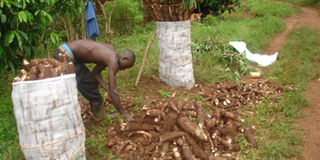Prime
Making plastic bags out of bitter cassava

What you need to know:
It is more than a food crop as there are many products that can be made from cassava.
Cassava is mainly used as a food crop for many who grow and those who consume it in the eastern, northern and central parts of the country. But, this is changing as some farmers are processing fine flour from cassava for supply to industries that make confectioneries.
Other uses
In other parts of the world, there are various non-food uses for cassava.
It is applied in manufacturing of paper, textiles, medicines and adhesives, among others.
Scientists at National Crops Resources Research Institute (NaCRRI) in Namulonge are making biodegradable plastics from cassava via a method known as bioprocessing.
Ephraim Nuwamanya, a scientist involved in the experiment, says they use the tubers and peels of the bitter cassava variety.
It is being carried out under Eastern Africa Agricultural Productivity project (EAAP) in conjunction with University College Cork in Ireland.
Reduce cyanide
The reason for the focus on bitter cassava is that it is neither consumed by human beings nor animals. It has a sizeable amount of cyanide thus unsafe for consumption.
This particular type is grown in most parts of West Nile and western Uganda in areas bordering Rwanda.
“Cassava consumers have tried to boil and ferment bitter cassava but it is still not good for human and animal health, this is the reason why we think it is good to utilise in biodegradable plastic products,” Nuwamanya said.
“We are using a technology which is not sophisticated but we need a technique, which will enable us rapture all the cells in the bitter cassava and destroy the cyanide.”
Alternative methods
Dr Steven Tumwesigye from National Agricultural Research Laboratories (NARL), who wrote a paper on processing of bitter cassava for packaging material, points out that bitter cassava cultivars have been utilised as an emergency food and less as alcohol, flour and starch.
The traditional methods applied in transforming roots into dried products had been a factor in low-value products and negative environmental impact.
This means an alternative for improved human safety and minimised environment impact is needed.
This is the basis for exploring the use of bitter cassava to produce biodegradable polythene paper in a bid to steer our agriculture from low-productivity enterprises to high-productivity commercial production.
Bitter cassava which has lasted in the field between 12 to 18 months is most appropriate.
“Both unpeeled and peeled roots are processed in two stages; mechanical tissue rupture and biopolymer release and recovery in order to obtain biopolymer powder to complete the entire process,” Dr Tumwesigye says. “Findings show that using both peeled and unpeeled roots has a positive impact in reducing the cyanide in bitter varieties.”
Environmental concerns
Application of sodium chloride also has a significant influence on the ratio in both the lined film product and in the interaction with peelings.
The experiment therefore means bioprocessing has a high chance of protecting the environment because of its indirect way of minimising waste.
Cassava as the main component in making packaging material is a unique one in eastern Africa. It is particularly important for cassava communities, which are exposed to environment-based dangers caused by bitter cassava.
The process
Ephraim Nuwamanya, who is part of the research to make biodegradable plastics from bitter cassava, explains the process: We get cassava root mainly from bitter cassava variety, crush it in order to obtain powder containing starch, protein, fibre and vitamins.
We mix this powder in water in the presence of sodium chloride, heat it and we get a paste out of it which is passed through a machine called thinner to make a film-like lining.
It is then put in an oven to dry to make polythene, which is put in a silk gel and later dried.
The product is what can be used to shape into a bag, mug, handbag and phone cover, among others.




